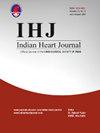IVUS derived plaque characteristics and outcomes in patients with acute coronary syndrome undergoing percutaneous intervention
IF 1.8
Q3 CARDIAC & CARDIOVASCULAR SYSTEMS
引用次数: 0
Abstract
Background
No/slow flow after percutaneous intervention(PCI) for acute coronary syndromes (ACS) is common. Whether a comprehensive intravascular ultrasound (IVUS) analysis of atherosclerotic plaque can define characteristics which predict suboptimal flow following PCI is largely unknown.
Objectives
To identify IVUS correlates of suboptimal flow in patients with ACS undergoing PCI.
Materials & methods
We performed a prospective multicentre, investigator initiated study. Patients with ACS, who underwent IVUS guided PCI were enrolled. Clinical, angiographic and imaging characteristics of patients who developed suboptimal flow after PCI were analysed and compared with patients with normal flow.
Results
Between October 2021 and August 2022, we enrolled 187 patients (195 lesions) with ACS who underwent IVUS guided PCI. Mean age of patients was 58 ± 10.4 years; Incidence of slow/no reflow in our study was 14/195 (7.2 %). Presentation as ST elevation myocardial infarction, presence of angiographically complex lesion type (type B2/C) and pre procedural TIMI flow 0 were significantly more in patients who developed suboptimal flow after PCI. Pre PCI plaque attenuation length (9.51 mm Vs 4.35 mm p = 0.037), lesion site positive remodelling (Odds ratio 6.4 : 95 % CI; 1.1–38.4 p = 0.042) were predictors of slow flow.Post PCI length of plaque prolapse (9.73 mm Vs 6.58 mm p = 0.029) correlated with slow flow.
Conclusions
Plaque characteristics on IVUS in patients with ACS helps to identify patients who may develop suboptimal flow following PCI.

急性冠状动脉综合征患者经皮介入治疗的Ivus衍生斑块特征和结果。
背景:急性冠脉综合征(ACS)经皮介入治疗(PCI)后无/慢血流是常见的。对动脉粥样硬化斑块进行全面的血管内超声(IVUS)分析是否可以确定预测PCI术后次优血流的特征,这在很大程度上是未知的。目的:确定IVUS与ACS行PCI患者亚理想血流的相关性材料与方法:我们进行了一项前瞻性多中心,研究者发起的研究。纳入了接受IVUS引导的ACS患者。分析PCI术后出现次优血流的患者的临床、血管造影和影像学特征,并与血流正常的患者进行比较。结果:在2021年10月至2022年8月期间,我们招募了187例ACS患者(195个病变),他们接受了IVUS引导的PCI。患者平均年龄58 + 10.4岁;在我们的研究中,缓慢/无回流的发生率为14/195(7.2%)。在PCI术后出现次优血流的患者中,表现为ST段抬高型心肌梗死,存在血管造影复杂病变类型(B2/C型)和术前TIMI血流0明显更多。PCI前斑块衰减长度(9.51mm Vs 4.35mm p=0.037),病变部位阳性重构(优势比6.4:95% CI;1.1 ~ 38.4 p=0.042)为血流缓慢的预测因子。PCI术后斑块脱垂长度(9.73mm Vs 6.58mm p=0.029)与血流缓慢相关。结论:ACS患者IVUS上的斑块特征有助于识别PCI术后可能出现次优血流的患者。
本文章由计算机程序翻译,如有差异,请以英文原文为准。
求助全文
约1分钟内获得全文
求助全文
来源期刊

Indian heart journal
CARDIAC & CARDIOVASCULAR SYSTEMS-
CiteScore
2.60
自引率
6.70%
发文量
82
审稿时长
52 days
期刊介绍:
Indian Heart Journal (IHJ) is the official peer-reviewed open access journal of Cardiological Society of India and accepts articles for publication from across the globe. The journal aims to promote high quality research and serve as a platform for dissemination of scientific information in cardiology with particular focus on South Asia. The journal aims to publish cutting edge research in the field of clinical as well as non-clinical cardiology - including cardiovascular medicine and surgery. Some of the topics covered are Heart Failure, Coronary Artery Disease, Hypertension, Interventional Cardiology, Cardiac Surgery, Valvular Heart Disease, Pulmonary Hypertension and Infective Endocarditis. IHJ open access invites original research articles, research briefs, perspective, case reports, case vignette, cardiovascular images, cardiovascular graphics, research letters, correspondence, reader forum, and interesting photographs, for publication. IHJ open access also publishes theme-based special issues and abstracts of papers presented at the annual conference of the Cardiological Society of India.
 求助内容:
求助内容: 应助结果提醒方式:
应助结果提醒方式:


